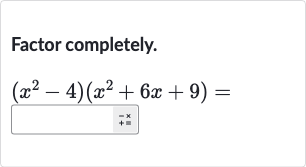AI tutor
Full solution
Q. Factor completely.
- Factorize first term: Factor the first term .The term is a difference of squares, which can be factored into .
- Factorize second term: Factor the second term .The term is a perfect square trinomial, which can be factored into or .
- Combine factored forms: Combine the factored forms of both terms.Now we have the factored forms of both terms: and . The completely factored form of the original expression is the product of these factored forms.
- Write final expression: Write the final factored expression.The final factored expression is .
More problems from Factor sums and differences of cubes
QuestionGet tutor help
QuestionGet tutor help

